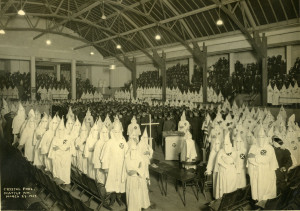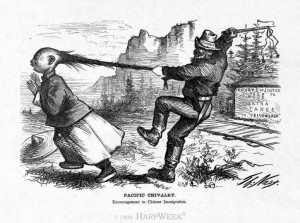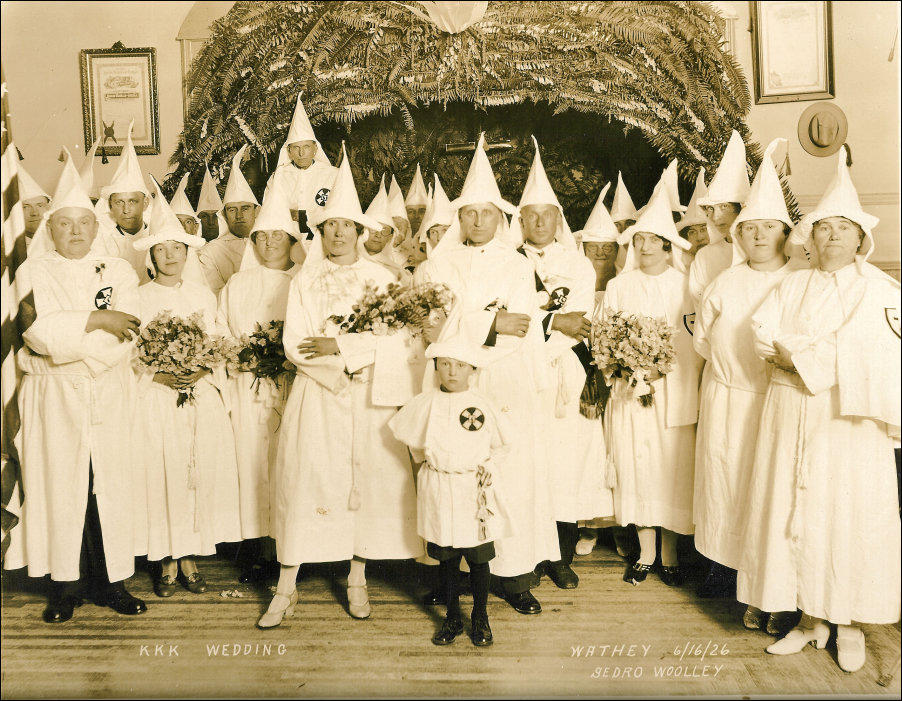The images are haunting. A family dressed in full Ku Klux Klan regalia prepares for a wedding in Sedro-Woolley. A downtown Seattle hall is filled to the rafters with folks in hooded garb for a Klan gathering. Stories circulate about one of the largest Klan rallies ever — with more than 25,000 people gathering in a field near Issaquah. Tens of thousands of whites living in Washington and Oregon were, for a time, enthusiastic members of an organization with one of the most hateful histories in America.
The shameful story of our region’s part in the Klan revival of the 1920s is well-documented. Inspired in part by movies like “Birth of a Nation” and a desire to mainstream white supremacy, the Klan resurgence of 1915 to 1930 was a national phenomenon, attempting to remake the Klan as a patriotic middle-class, fraternal organization no more threatening to whites than the Elks or Eagles.
What is less well-documented is that the first stirrings of the Klan on the West Coast and in the Pacific Northwest appear to have occurred much earlier. Looking at our histories, you would think nothing like the Klan tainted our evergreen shores until the early 20th century. But on closer look, the first signs of the Ku Klux Klan in California and Oregon go back nearly to the birth of the Klan itself half a century before that revival. Indeed, as I’ve found as a result of writing about the ugly strains of racism in our region, historians are concluding that the Western states, as much as the Deep South, were a battleground of race, class and immigration both before and after the Civil War.
Nearly 150 years ago, as early as 1868 — following shortly on the Klan’s post-war birth in Reconstruction-era Tennessee — the KKK’s influence vaulted the Rocky Mountains to inspire a spate of racially-focused night raids, robberies, threats and arson attacks on the West Coast stretching from Southern California to Western Oregon. This was no Klan revival, it was Klan behavior in the West almost from Day One.
“Vengeance is at Hand!”
A circular nailed to a tree in the Livermore Valley in the San Francisco Bay Area in the spring of 1868 raised the question in a San Francisco Bulletin headline, “Have We the Kuk [sic] Klux Klan Among Us?” The newspaper reprinted a Klan missive that declared, “Action! Action! Action! Fellow members of the KKK the days of oppression and tyranny is past [sic], retribution and vengeance is (sic) at hand.” The note threatened to “sheath daggers” in the sleeping breasts of those who seek “enslavement of a free people.”
That reference to enslaving free people did not refer to blacks, Hispanics, Indians or Asian immigrants but rather to the “free” white man who was feeling oppressed by the labor conditions of the post-Civil War West. In a pattern that, some would say, has echoes today here and abroad, whites of the Reconstruction Era often recast the narrative to focus on their supposed victimhood at the hands of radical Northern whites and freed blacks. African Americans were relatively few on the Coast, but a surge of Chinese immigrants was perceived as undercutting the labor market for Caucasians. The immigrants were targeted for lynching, terror and forced removals. And anti-Chinese sentiment on the Coast led to the United States’ first and most sweeping race-based anti-immigrant laws.
The writer at the San Francisco Bulletin didn’t take the KKK announcement too seriously, believing the author of the circular likely “drew his inspiration from a whiskey bottle.” But this note did not come in isolation nor did the California Klan emerge from a local history that was bloodless, even if the state had been removed from the main action in the Civil War. And men claiming to be the Klan soon became shadowy players in West Coast politics, supported by a strong and sometimes dominant ideological thread of white supremacism. In 1879, California state (and later U.S.) Sen. John S. Hager said, “I believe this country of ours was destined for the Caucasians — our own white race,” a belief still echoed and tweeted by some politicians today.

To be honest, the KKK had very little to teach Pacific Coast settlers when it came to racist violence. Oregon had banned blacks and mulattoes from living there in its state constitution and was infamous for a series of black exclusion laws. Volunteer militias from the coastal states and territories swept through the West before, during and after the Civil War, ethnically cleansing the region of Native Americans. There had been a long record of violence between whites and Hispanics. Early in the California Gold Rush, white miners from Oregon descended into the California gold fields and drove out and massacred Native American workers employed at the diggings by California rancheros. The West was also known for vigilante justice, widely supported as necessary to social order. Racial violence in the region was well-established long before the KKK came along.
A scholar who has honed in on signs of the early KKK is Kevin Waite, currently an assistant professor of history at the University of Durham in England. His recent dissertation, “The Slave South in the Far West: California, The Pacific, And Proslavery Vision of Empire,” demonstrates how the West Coast, especially California, was deeply steeped in a version of Manifest Destiny driven by Southern slaveholder interests.
A Cornucopia for Racists
Even from the start, despite California’s entry into the Union as a free state, many dreamed of extending slavery to the West Coast. Oregon State University professor Stacy L. Smith in her book “Freedom’s Frontier: California and the Struggle Over Unfree Labor, Emancipation and Reconstruction” has documented the complex “unfree” labor systems that existed in the region, which included Chinese “coolies,” contract workers from the Pacific islands, Mexican “peons,” enslaved Native Americans, as well as, in the antebellum period, black slaves brought into the territory as “property.” Waite describes the scene as “a cornucopia for racists.”
This multi-cultural workforce — the first of its kind in the country — presented challenges. In the post-Civil War period, white laborers felt the Chinese “threat” and contemporary newspaper records are full of examples of violence against the Chinese. In the late 1860s, a number of perpetrators claimed, for the first time, to be members of local, self-started Ku Klux Klan groups. A Methodist Church in San Jose was threatened and set afire by a self-proclaimed Klan group in 1869 because the church had opened a Sunday school for Chinese children. In the Home Missionary Magazine under the heading of “Ku Klux in California,” the Rev. Otis Gibson reported the church's work has “started the devil from his lair.” In response to the attack, Gibson said he had helped to organize 14 Sunday schools teaching some 400 Chinese. “We propose to push [the devil] hard.”
The devil continued to be busy. Another church in Sacramento was torched. Arsonists burned a white-owned brandy distillery for employing Chinese workers. Farmers were attacked and their Chinese workers terrorized and abused in Santa Cruz. In the Grass Valley north of Sacramento, masked hoodlums, reportedly KKK members, robbed and tortured Chinese ranch hands. Waite reports: “California Klansmen generally assaulted Chinese immigrants and their white employers, while occasionally threatening Republican politicians and journalists as well.” The tactics playing out in the South were becoming prevalent in the Golden State.

West Coast KKK: Rebranding Terrorism
There is no definitive proof that these groups were tied to the KKK in the South — even Southern Klan groups were often local and not necessarily part of a larger organization. Also, much of the racist violence in the South wasn’t even associated with the Klan per se but perpetrated as a matter of course by white authorities.
The KKK-claimed depredations on the Coast were not even the worst acts committed against Chinese immigrants; terrorism of the Chinese went on long after anti-Chinese vigilantes stopped claiming to be Klan-connected. The emergence of the Klan label in the West seems to have been a kind of rebranding exercise, latching onto the Klan image to boost terror, says Smith. The political divisions between North and South extended to Pacific Coast politics. California and Oregon did not vote to ratify the 14th or 15th amendments to the U.S. Constitution, failing to endorse equal rights, due process and citizenship regardless of race. With their passage, some whites dug in to ensure that such rights were not extended to others, especially “heathens” like Native Americans and the Chinese. Western workers, they believed, should be free, white and Christian.
The KKK brand spoke to a mainstream political divide between the Republicans, who were generally more supportive or tolerant of civil rights reform, and Democrats, who more often openly espoused white supremacist, anti-Reconstruction doctrine. The Klan brand spoke to that racist agenda, with the additional promise of violence to enforce its will.
The Dixie of the Pacific Northwest
Before the Klan, there was a precedent on the Coast for secretive, guerilla-style groups. A predecessor was the Knights of the Golden Circle, Southern sympathizers who promoted secession of the Confederacy and a larger, hemispheric plan to spread slavery. During the War, they were said to operate as a kind of Fifth Column in the North and in the West. They formed a secretive, armed group—also sometimes called the Knights of the Columbian Star--who schemed to take California, Oregon and Washington Territory out of the union to form a Pacific Republic sympathetic to the South. The Knights are considered by historians to have provided a template for the post-war Klan.
What was happening in California was also going on in Oregon. In 1869, The Oregonian reported that the KKK was organizing against woolen mill owners in Portland who employed Chinese workers. A leaked internal message to the group stated, “We would recommend that we assume the name of the Ku-Klux-Klan, and that we will observe the strictest secrecy in our proceedings except what is ordered to be given to the public through the press.” The group was said to pledge to buy no goods from any place where Chinese labor was employed and had wrapped itself in the guise of a labor organization.
The Oregonian, a Republican paper, speculated that the Portland Klan had larcenous intent. “It may be that this Ku Klux Klan, in imitation of the operation of its prototype of the same name in the Southern States will begin by ‘cleaning out’ the ‘inferior races.’ The industrious Chinese and negroes of Portland have accumulated enough to be quite a plunderable squad and would yield very fair booty for the ‘working men’ of the Klan,” the paper mocked.
Southwestern Oregon had been a stronghold of Southern sympathizers before, during and after the Civil War. Three Oregon counties, Douglas, Jackson and Josephine, have been called the “Dixie of the Pacific Northwest” by historian Jeff LaLande. The region was heavily settled by Democrats from border and Midwest states, many of whom opposed the war or openly favored the Confederacy. Some flew the rebel flag during the war and there had been minor insurrectionist activities and conspiracies that spilled into the post-war period.
In 1866 near Roseburg, a feud between Democrats and Republicans that festered between families on opposite sides of the political divide blew up at a Christmas Day dance when Southern sympathizers attacked pro-Union locals with guns and knives. The event, called the “Champagne Riot,” left two dead and a number injured, and an open political wound.
The Klan as “Fake News”
In 1868, Democrats took over the state legislature and Republican newspapers took to calling it the “Ku Klux legislature” for its open sympathies to the South and opposition to Reconstruction policies. In the wake of a bitter presidential campaign in 1868 (the West swung Republican to elect Ulysses Grant, but not Oregon), accusations of Klan sympathies flew while Democrats pooh-poohed them as the fevered imaginings of Republicans. Said one Oregon Democratic paper, the Klan “myth” was “one of the most stupendous, persistent and wicked lies that ever claimed paternity of man or demon.” As the federal government cracked down on Southern Klan violence, many Democrats took the tack that the KKK simply did not exist, saying, in essence, “fake news.”
We know, of course, that the Klan did exist. Though it faded for a time at the end of Reconstruction, as did claims or accusations of West Coast Klan activity, racial violence in the West against people of color continued unabated. It terms of the Chinese, it included an infamous riot and mass lynching in Los Angeles’ Chinatown in 1871, and later forced Chinese exclusions in Seattle and Tacoma. There was also a massacre of Chinese miners in Oregon in the 1880s.
The Klan has “revived” in several eras, and still exists as do the attitudes that caused it to flourish — evidenced by the recent comments of Rep. Steve King of Iowa, the influence of white nationalists at the White House, and the push for a Mexican border wall and the president’s ban of refugees from some Muslim countries. Add to that the surge of threats and anti-Semitic vandalism against synagogues and other Jewish institutions, including some in Seattle and Mercer Island. KKK literature has also resurfaced on college campuses, including the University of Washington.
While we face a possible new rise in national Klan or Klan-style activity, it is important to remember that these attitudes are embedded in the founding of our region — think of it as Ecotopia’s dark side. Rather than an alien presence, these acts and attitudes are part of our political and cultural fabric. Times like these should reawaken our interest in dealing with the devil in his lair, and the devil in our region’s origins.



